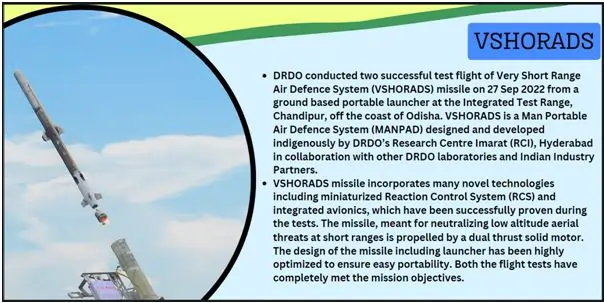
The new VSHORADS the 4th generation of air defence system is in a class of its own in comparison to the previous models providing improved capacities to counter new air threat. In this article, we will explores the characteristic of 4th generation VSHORADS, benefits accruable from it, and why it is relevant for strategic application.Very Short Range Air Defence Systems (VSHORADS) are tactical designed to offer point protection against Low Flying Aircraft including hostile aircraft, UAVs, and missiles. The 4th generation VSHORADS also includes the development made in the prior generations and encapsulates the current state of the art in technology to create a considerably enhanced platform.
Key Features
- Man-Portable Design: In its 4th generation, the VSHORADS has been designed for portability and can be operated as a man portable air defence system. This makes it suitable for use in any theatre of operations by infantry formations and Special Forces operating in diverse terrains.
- Advanced Targeting Systems: With effective electro-optical and target acquisition systems, ground moving targets, as well as air targets can be accurately engaged by the 4th generation VSHORADS. This capability improves its operational efficiency when it comes to ever-changing battle.
- High-Speed Interception: This system is capable of tracking high velocity targets with the maximum range and altitude. This makes it possible for even speeding threats to be dealt with in the best way possible.
- Hit-to-Kill Capability: More about the 4th generation VSHORADS is that it is equipped with the ability to hit a target and destroy it. This is especially important in areas with high population density or close to important installations and as of its efficiency it only hits the targets without causing danger to its surroundings.
- Miniaturization: Technological enhancement in miniaturization has boosted the construction of smaller and less bulky VSHORADS systems. This increases mobility and operations efficiency without significant loss in performance.

Strategic Importance
- Enhanced Air Defence Capabilities: The newest 4th generation VSHORADS makes a real tremendous impact on the air protection of a country. For this reason it improves overall security and protection by offering a safe and efficient way of engaging low flying threats.
- Counter-Drone Operations: As the reconnaissance and strike UAVs are more commonly used for surveillance and attacks, the 4th generation VSHORADS assumes the counter-drone applicability. Hence, the ability to capture and overwhelm drones affords airspace protection.
- Support for Ground Forces: In defending ground forces on a tactical level, the 4th generation VSHORADS helps secure the forces’ operating environment. This is so especially in the unconventional conflict situation where one side lacks comparable power as the other.
- Flexibility and Adaptability: One of the prominent features is portability of the system designed for handling by manpower and an array of target designation systems. The four generation VSHORADS can work effectively in plain areas just as effectively as in city areas, steep terrains and large open spaces.
Advantages over Previous Generations
- Improved Accuracy: It has been established that the new targeting systems in the 4th generation VSHORADS are more accurate than those of the earlier models. This makes sure that targets are impacted with high accuracy thereby minimizing the effects on other parties.
- Enhanced Mobility: The portability and compactness of the 4th generation VSHORADS is improved because it is man-portable and made light. This enables quick deployment and redeployment which serves well in the combative environment.
- Greater Range and Altitude: While at high ranges and altitude the capability of the system to intercept targets offers a more expansive defence. This is especially important in safeguarding strategic physical and informational property and installation.
- Reduced Response Time: The pointing and saddle capabilities of the 4th generation VSHORADS are exceptional and faster compared to the preceding generations, thereby enabling the fast elimination of risks. This is astoundingly important especially in high intensity battles.
The 4th generation VSHORADS is an enhanced system in air defence capability. In modern warfare, its man-portable nature, along with sophisticated targeting and engaging and high interception velocity and kill-first principle make it an important weapon system. In protecting the homeland’s critical assets and safeguarding national security, the ability in raising air defence efficiency, facilitating ground forces, and deploying counter-drone operations is indispensable with 4th generation VSHORADS. Such systems will always be vital as technology grows with time to meet new challenges in an adequately fortified defence system.
Significance for India
The 4th generation Very Short Range Air Defence System (VSHORADS) is strategically and tactically of very high importance for India. Due to change in security paradigm and growing sophistication of threat in aerial domain, a presence of Fourth generation VSHORADS in Indian Defence system is vital to strength the National Security System of India.
Improved capability of Air Defence System
India has a range as well as a versatility of security threats, from being threatened by hostile neighbours and non-state actors. The newly developed 4th generation VSHORADS increases India’s air defence capability through provides an effective method to neutralise low altitude aerial threats such as drones, helicopters and aircrafts. From these points, this system is essential for defending military compounds, major facilities, and cities against aspiring aerial threats.
Countering Asymmetric Warfare
Finally, a technological advancement where drone and other UAVs are increasingly used by insurgent and terrorists, the 4th generation VSHORADS is needed to deter asymmetric threat. The fact that intercepts and disable drones means that the airspace of India is safeguarded against reconnaissance and possibly Actual attacks on key interests.
Support for Ground Forces
Due to the man-portable characteristics of the 4th generation VSHORADS the system plays crucial role in the modern ground forces. It affords point defence for those troops who are involved in different terrains such as frontier areas and hotspots. This improves operational capability of the Indian army to a level that soldier can guarantee accomplishment of their mission with maximum safety.
Strategic Deterrence
Having such super-modern air defence systems such as the 4th generation VSHORADS is handy when it comes to deterring any probable rivals. Hence, understanding that India is capable of holding out aerial threats brings self-restraint and general security because it provides enough security which escapes aggression. The ultimate goal of these barriers is to deter any country from the region from mimicking Iran and North Korea’s nuclear advancements.
Technological Advancements
The 4th generation VSHORADS embody India’s capabilities in not only in the research and development of defence technologies but also in field deployment as well. It serves as evidence of the country’s capacity for independent invention and adoption of the advanced new technologies, while serving as a boon for the domestic defence manufacturing industry. Thus, this self-sufficiency in defence technology does not only provide a breaking point into foreign suppliers, but also helps boost the country’s economy as well as provide jobs for the people.
Strengthening Defence Diplomacy
India’s capacity to indigenously design and produce state of the art Air defence systems boosts India’s reputation in the global defence fraternity. It generates opportunities for engaging in defence relations and partnership with other nations fostering defence diplomacy. This way, expertise and technology can be exchanged for the creation of strategic and partnering relationships that promote security in the region and the world.
DRDO
The Defence Research and Development Organisation (DRDO) is undeniably one of the strong pillars of Indian defence system. DRDO was set up in 1958 and works under the Ministry of Defence with a focus of delivering innovative defence technologies. Only such contributions are critical in making certain that the Indian defence establishments receive only the best defence equipment as well as strategic systems.
Evolution and Mission
From the initial stage of its formation, we can clearly see the improvement of DRDO in present days. Indeed, an organisation that was originally formed with ten laboratories has now expanded and transformed into a network of over fifty laboratories and establishments throughout the country. The main objective of DRDO is to develop indigenous capabilities in defence products and systems demanded for today’s and tomorrow’s warfare.
Key Areas of Research
A variety of areas constitutes DRDO’s research that can be attributed to the intricacies of modern day defence needs. Some of the key areas include:
- Missile Systems: Some of the systems under the ballistic missiles are Agni missiles and Prithvi missiles; the surface to air system like Akash, and the anti-tank system like Nag. These systems greatly contribute to India strategic retribution and safeguard in general.
- Aeronautics: In aviation DRDO has come up with the Light Combat Aircrafts Tejas which is a clear indicator of Indian Home-grown fighter aircraft. The organisation is also investing in unmanned aerial vehicles (UAVs) and other high-technology aircraft control systems.
- Armaments and Combat Engineering: Indian Armament has been outcome-oriented in developing artillery systems, small arms, ammunition by DRDO. DRDO has been actively involved in the sphere of combat engineering and has given the Indian Army one of its significant frontline assets, viz., Arjun Main Battle Tank.
- Electronics and Cyber Systems: For research and development of electronics, communication systems as well as cyber systems, DRDO has its primary attention. This encompasses; the radar, electronic warfare apparatus, and secure communication gear such as the radios, telephone lines etc.
- Naval Systems: This organization has been helpful in the technological advancement of a number of naval equipment such as sonar systems, torpedoes and underwater surveillance equipment establishing and enhancing India’s naval power.
- Life Sciences: It also works in the field of life sciences for increase in wellness and productivity for the use of armed forces. Such as the issue of Infantry, Equipment, Nutrition and Medical facilities for Soldiers operating at certain Climates.
Strategic Impact
The work DRDO does for India is very significant and has resonance for India’s strategic and defence settings. In the process, indigenous technologies are fostered so that Indian defence systems are not over-dependant on foreign suppliers. In this connection, European interest in reviving ‘strategic autonomy’ means it needs to rely on itself to ensure strategic security.
But it is pertinent to mention that like other defence organizations, DRDO inventions are technologically also useful for civil usage. Technologies implemented for use in military uses are usually adopted in sectors such as; medical, transport and IT.
Issues and Outlook
Nevertheless, there are several problems concern to DRDO, the most significant of which are the lack of close cooperation with private sector and academic institutions, speeding up the transfer of technology to the country’s military forces, and increasing investments for research and development programs. To carry out its mandate effectively, it requires overcoming these challenges.Therefore, the focus of DRDO in the future is in areas including artificial intelligence, quantum computing and lasers, hypersonic and ballistic weapons, and space defence systems. Thus, DRDO plans to remain abreast of current technology so that Indian defence capabilities are not caught unprepared against any threat.
Consequently, the DRDO is now more than ever a vital cog in the wheel for research and innovation in defence for the country. Its focus on research and development of new technologies and systems has in fact powered up with India’s military forces. In this ever-dynamic security environment across the world, the efforts put by DRDO regarding innovation and indigenization shall always hold significance in terms of the sovereignty and security interests of the nation. By doing so, the DRDO maintains the strength of a diverse nation of and for its people through innovation as the drive for success endures.